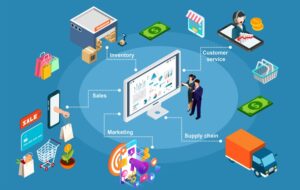1. Introduction
In today’s rapidly evolving business landscape, data-driven decision-making has become an essential element for success. The fusion of predictive analytics and business intelligence (BI) enables organizations to harness the power of data and analytics to gain valuable insights, drive strategic decisions, and maximize efficiency. This article will explore the transformative potential of these two approaches and their integration, shedding light on their potential to revolutionize the business world.

2. Predictive Analytics: A Powerful Tool for Business
Predictive analytics is a method used to analyze historical data to make accurate predictions about future events. By leveraging advanced statistical techniques and machine learning algorithms, predictive analytics enables businesses to forecast customer behavior, identify trends, and optimize operations.
2.1 Real-world Applications of Predictive Analytics
- Marketing and Sales: Predictive analytics can help businesses optimize their marketing campaigns and sales strategies by analyzing customer data to identify patterns and trends, leading to more targeted and personalized offerings.
- Supply Chain Management: By predicting demand fluctuations and potential disruptions, predictive analytics can help businesses optimize their inventory levels, streamline their supply chain processes, and reduce costs.
- Risk Management: Predictive analytics allows companies to identify potential risks and vulnerabilities in their operations, enabling them to implement proactive measures to mitigate potential issues.
3. Business Intelligence: Turning Data into Action
Business intelligence (BI) is a set of tools and processes that enable organizations to collect, analyze, and visualize data to make informed decisions. BI involves the use of technologies such as data warehousing, data mining, and reporting tools to derive actionable insights from large volumes of data.
3.1 Real-world Applications of Business Intelligence
Performance Measurement: BI tools enable businesses to track key performance indicators (KPIs) and measure their progress against set goals, allowing for continuous improvement and strategic decision-making.
- Market Analysis: By analyzing market data and trends, BI tools can help organizations identify opportunities and threats, enabling them to adapt and stay competitive in the market.
- Customer Analysis: BI tools can help businesses better understand their customers by analyzing customer data to identify preferences, needs, and behaviors, ultimately leading to more effective customer service and improved customer retention.
4. Integration of Predictive Analytics and Business Intelligence
By combining the strengths of predictive analytics and business intelligence, organizations can create a powerful data-driven decision-making framework. The integration of these two approaches provides businesses with a comprehensive view of their operations, empowering them to make data-backed decisions and effectively respond to market trends and customer needs.
4.1 Benefits of Integration
- Enhanced Decision-Making: The integration of predictive analytics and BI enables businesses to make more accurate and informed decisions by leveraging the power of data and analytics.
- Improved Operational Efficiency: By combining the predictive capabilities of analytics with the actionable insights provided by BI tools, businesses can streamline their operations, reduce costs, and increase productivity.
- Increased Competitiveness: The integrated approach allows businesses to stay ahead of their competition by quickly identifying market trends, customer preferences, and potential risks, enabling them to adapt their strategies and maintain a competitive edge.
- Innovation and Growth: The fusion of predictive analytics and BI empowers organizations to discover new opportunities and explore innovative ideas, fostering growth and expansion.
5. Future Directions and Challenges
As the business landscape continues to evolve, the integration of predictive analytics and business intelligence will play an increasingly crucial role in shaping the future of organizations. However, several challenges and trends must be considered as businesses strive to harness the full potential of these technologies.
5.1 Evolving Trends in the Industry
- Artificial Intelligence and Machine Learning: The incorporation of AI and machine learning algorithms into predictive analytics and BI tools will continue to enhance their capabilities, enabling more accurate predictions, better decision-making, and increased automation.
- Big Data: The exponential growth of data presents both opportunities and challenges for businesses. Organizations must effectively manage and process vast amounts of data to extract valuable insights, necessitating scalable and robust data management systems.
- Data Privacy and Security: As data becomes increasingly vital for businesses, ensuring data privacy and security is paramount. Organizations must implement stringent security measures and adhere to data protection regulations to safeguard sensitive information and maintain customer trust.
5.2 Ethical Considerations
As businesses increasingly rely on data and analytics, ethical considerations surrounding data usage and algorithmic bias must be addressed. Organizations should prioritize transparency and fairness in their data practices and actively work to mitigate potential biases in their algorithms to ensure equitable decision-making and maintain public trust.
6. Conclusion
The integration of predictive analytics and business intelligence has the potential to revolutionize the business landscape by empowering organizations to make data-driven decisions, optimize operations, and stay competitive in an increasingly complex market. By harnessing the power of these technologies, businesses can unlock new opportunities for innovation and growth while navigating the challenges and trends that will define the future of the industry.
7. FAQ
Q1: What is the difference between predictive analytics and business intelligence?
A1: Predictive analytics focuses on analyzing historical data to make accurate predictions about future events using advanced statistical techniques and machine learning algorithms. Business intelligence, on the other hand, involves collecting, analyzing, and visualizing data to make informed decisions using various technologies and tools.
Q2: How can the integration of predictive analytics and business intelligence benefit businesses?
A2: The integration of these two approaches provides businesses with a comprehensive view of their operations, enabling data-backed decision-making, improved operational efficiency, increased competitiveness, and fostering innovation and growth.
Q3: What are some challenges and trends businesses should consider when implementing predictive analytics and business intelligence?
A3: Businesses should consider evolving trends such as the incorporation of AI and machine learning, big data management, and data privacy and security. Additionally, ethical considerations surrounding data usage and algorithmic bias must be addressed to ensure equitable decision-making and maintain public trust.
Q4: Can predictive analytics and business intelligence be applied to small businesses?
A4: Yes, both predictive analytics and business intelligence can be scaled to fit the needs of small businesses. By implementing these technologies, small businesses can benefit from data-driven decision-making, improved efficiency, and increased competitiveness, just like larger organizations.
